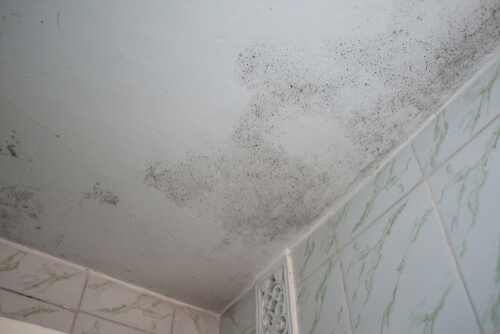Peeling back the curtain on a common household nemesis and removing mold from bathroom ceiling is like tackling an unwelcome guest that refuses to leave. From spotting those first ominous spots to understanding why they’ve chosen your bathroom as their breeding ground, we’ll guide you through identifying mold types and distinguishing them from mildew. We dive into DIY removal techniques using items likely already in your cupboard—think white vinegar and baking soda—and when it’s time to call in the pros for backup.
Table Of Contents:
- Discerning the Causes of Bathroom Ceiling Mold
- Identifying Bathroom Ceiling Mold
- Health Threats of Bathroom Ceiling Mold
- Courses of Action for DIY Removing Mold From Bathroom Ceilings
- Acknowledging When to Seek Professional Assistance for Mold Removal
- Maintaining a Mold-Free Bathroom Ceiling Post-Removal
- The Process of Choosing a Reliable Mold Removal Company
- Conclusion
Discerning the Causes of Bathroom Ceiling Mold
Removing mold from bathroom ceiling isn’t just a blot on your home’s beauty—it’s a cry for help from an environment struggling to breathe. When warm temperatures meet excess moisture and inadequate ventilation, you’ve got the perfect storm for mold growth. It’s like throwing a party where mold spores are the only guests invited.
Usual Causes
The main culprits behind that unwanted ceiling decor? Everyday activities like hot showers without proper air circulation. Imagine each steamy shower as another invitation sent out to those pesky mold spores. And with inadequate ventilation being one of the primary causes, it’s clear our bathrooms often miss out on the memo about airing things out.
Warm temperatures play their part too, offering those spores a cozy spot to settle down and multiply. Combine that warmth with excess moisture—another key stat in this story—and you’ve laid down the welcome mat for mold right there on your bathroom ceiling. Whether it’s through better ventilation systems or simple habits like opening a window post-shower, keeping humidity levels in check can save your ceilings and protect your health.
Identifying Bathroom Ceiling Mold
Spotting how to remove mold on your bathroom ceiling can be like finding an unwanted guest at a party. But how do you know if it’s just a harmless visitor or something more sinister? Embarking on the quest to differentiate bathroom ceiling mold, we’re zeroing in on the subtle yet pivotal battle between mold and its less menacing cousin, mildew.
Mold vs Mildew
Distinguishing between these two is crucial because their impact on your health and home varies significantly. Mold tends to have a fuzzier appearance and comes in various colors – black, green, red, or blue. On the other hand, mildew usually presents as powdery white or gray patches. While both thrive in moist environments found in bathrooms, black mold is notably darker and carries more severe health risks than its counterpart.
Health Threats of Bathroom Ceiling Mold
Mold growing on your bathroom ceiling isn’t just an unsightly issue—it’s a health hazard. Breathing in mold spores might kick off allergies, set off asthma flare-ups, and could pave the way to catching lung infections.
Among the common types of mold found in bathrooms is black mold which is known to be particularly dangerous because it produces toxins called mycotoxins that can cause serious health issues. People with pre-existing conditions or those who have immune system challenges may find themselves more susceptible to problems arising from exposure to this type of mold.
If you’re unsure about tackling this problem yourself or if you’ve discovered extensive contamination, seeking professional help might be the best course of action. You’ll want expertise on your side when dealing with severe infestations that could compromise air quality further or pose greater risk factors for household members’ health.
Courses of Action for DIY Removing Mold From Bathroom Ceilings
Thankfully, tackling small areas of mold is something you can do with items likely already in your home. Here’s how to say goodbye to that unwelcome guest.
DIY Mold Removal Essentials
To start cleaning, you’ll need white vinegar, baking soda, or hydrogen peroxide—your choice depends on what’s available and personal preference since all are effective against those pesky mold spores. White vinegar is a great solution because it attacks mold at the root without adding harmful chemicals to your air quality.
Baking soda not only helps clean mold but also deodorizes the area and leaving your bathroom smelling fresh. Hydrogen peroxide acts as a non-toxic bleach solution that kills mold while being safe for use around pets and kids when used properly.
The Cleaning Operation
First off, wear protective gear like gloves, eye protection, and a face mask to avoid inhaling any mold spores or getting cleaning solutions in sensitive places. Mix your chosen cleaner (vinegar or hydrogen peroxide) with warm water in a spray bottle; for baking soda add just enough water to form a paste.
Spray or apply directly onto the affected area and let it sit for about an hour before scrubbing with a brush—this gives the solution time to penetrate deep where mold grows. Afterward, wipe clean, then allow the area to air dry completely, which prevents future growth by keeping moisture levels down.
Acknowledging When to Seek Professional Assistance for Mold Removal
Mold remediation professionals are like the superheroes of the cleaning world. Armed with sophisticated gadgets and deep knowledge, they intervene precisely when mold problems surpass the realm of simple home remedies. If you’re standing on a ladder, staring at your bathroom ceiling covered in mold despite your best efforts, it might be time to call in the pros.
Maintaining a Mold-Free Bathroom Ceiling Post-Removal
Once you’ve conquered the mold on your bathroom ceiling, ensuring it doesn’t dare come back is essential. The key lies in addressing the factors that invited mold in the first place: high moisture and poor ventilation.
To keep your bathroom ceiling pristine, improving air circulation is non-negotiable. Slapping in a vent fan does the trick, sucking up all that mist from your hot showers and baths, cutting down on the dampness. If you already have one, make sure it’s powerful enough for your space, or consider an upgrade.
Halt Further Growth Using Straightforward Methods
A mix of prevention and maintenance keeps mold at bay effectively. Regularly cleaning your bathroom with a solution mix of undiluted white vinegar not only cleans but attacks mold spores before they settle.
In areas prone to water damage or where excessive moisture lingers despite best efforts, consider using mildew-resistant paint as a barrier on your cleaned ceilings; this helps seal off surfaces from future invasions. Adopt these tactics to prolong your triumph in safeguarding your space.
The Process of Choosing a Reliable Mold Removal Company
When your bathroom ceiling starts resembling a science experiment more than part of your home, it’s time to call in the experts. But not just any squad wearing hazmat suits will do. You need a mold removal company that knows their stuff inside and out.
Finding a reliable service provider means looking beyond flashy ads or the first Google result. Initiate your search by scrutinizing their qualifications and official endorsements. Companies worth their salt are usually certified by industry standards such as the Institute of Inspection Cleaning and Restoration Certification (IICRC).
Conclusion
Mastering removing mold from bathroom ceiling means tackling the root causes: moisture, warmth, and poor ventilation. Identify your enemy—mold isn’t mildew—and know when it’s a DIY fix or time for professional help. Just so you know, white vinegar and baking soda might just turn out to be your best friends in tackling this issue. Keep that air moving and humidity low.

